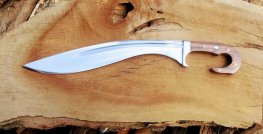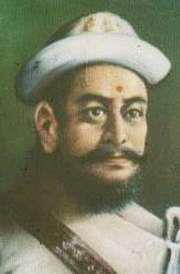What is Khukuri / Kukri?

Kopis, designed by GGK. It is the Greek sword, which many believe inspired the design of Kukri in the Indian sub-continent.
 Then there are the Gorkhas who did more than anybody to bring this knife to the attention of the world. For years, even centuries, the blade form lay dormant in the world, being kept alive only in India and Nepal. And then the Gorkhas appeared on the world scene a couple of hundred years ago and brought with them their traditional weapon, the khukuri. Because the Gorkhas were probably the best mercenary force the world has ever seen and may ever see part of their fame became the fame of the khukuri. Gurkhas and khukuris both are synonymous. Khukurki without Gurkhas and Gurkhas without khukuri are unthinkable and unimaginable. With this legendary multi-utility real functional weapon The Great King from Gorkha Prithivi Narayan shah carried the unification campaign and annexed 22-24smaller states into the strong unified “Nepal”. Even before him the Malla kings also used khukuri as their weapon.The khukuri is a daily household utility tool for common Nepalis from dawn to dusk assisting in their daily household chores like cutting meat, whittling twigs, making ways clearing bushes etc and is the security companion.
Then there are the Gorkhas who did more than anybody to bring this knife to the attention of the world. For years, even centuries, the blade form lay dormant in the world, being kept alive only in India and Nepal. And then the Gorkhas appeared on the world scene a couple of hundred years ago and brought with them their traditional weapon, the khukuri. Because the Gorkhas were probably the best mercenary force the world has ever seen and may ever see part of their fame became the fame of the khukuri. Gurkhas and khukuris both are synonymous. Khukurki without Gurkhas and Gurkhas without khukuri are unthinkable and unimaginable. With this legendary multi-utility real functional weapon The Great King from Gorkha Prithivi Narayan shah carried the unification campaign and annexed 22-24smaller states into the strong unified “Nepal”. Even before him the Malla kings also used khukuri as their weapon.The khukuri is a daily household utility tool for common Nepalis from dawn to dusk assisting in their daily household chores like cutting meat, whittling twigs, making ways clearing bushes etc and is the security companion.
It is also an important and integral part of our Nepalese culture – it represents our history, traditions, and spiritual beliefs. It serves as a symbol of wealth, social status, and prestige in Nepalese culture – It even has a clearly defined social role as an article of dress. For example, no well-dressed Nepalese groom would ever think of appearing at his wedding ceremony without his finest khukuri at his side.
Even today, it plays an important spiritual role in the traditional rituals of the various different ethnic groups of Nepal: As a spiritual talisman, it is worshiped and paid respect and loyalty to, along with other useful iron and steel tools, during Dashain (the longest and most important festival in the Nepalese calendar), and at other times whenever any sacrifice is to be made. The traditional, ancient belief is that a khukuri kept in the home is said to bring good fortune and ward off evil spirits. Our ancient custom – still observed in traditional households – is that when we retire at night it is even placed under our pillows to prevent bad dreams, and dispel evil influences and thoughts.
Similarly there were several events in World War I and World War II where khukuri was used as a lethal weapon. At the time of war when Italy had kept soldiers captive, the Gurkhas with their khukuri managed to rescue the soldiers from their territory. Though more modern weapons such as tanks, atom bombs, machine gun were major weapons khukuri still prevailed as an important weapon during the world wars. This is the reason British Gurkha, Singapore Army, Bahrain Army still carry khukuri as a matter of pride till date.
Khukuri is the glory of national pride, valor in battle and insigna of success with glorious history upheld by the brave Gurkhas.While purchasing khukuri 2 small knifes which are called Karda and Chakmak are also provided along with it.
Karda :- A small Knife tucked behind the scabbard. Its main purpose is to cut small things and also work as a skinning knife and to make small holes.
Chakmak :- It is a blunt knife and is used to sharpen the khukuri and also could be used to light fire with the use of stone.
Notch :- The notch near the handle of the blade is a Hindu fertility symbol. It is also the weapon of shiva and it is known as trident So the notch forbids slaughtering sacred animal with it. The Gurkhas also kept promises with it that they will never use this weapon on women and children. Nevertheless, the knife being the lethal weapon, the notch on it is for the blood to drip off rather than running onto the handle, and thereby prevent the handle from becoming slippery, so the user can maintain his grip for further demonstration.The other most important thing about this is no other knife has this distinctive character in them and only khukuri is the design where we can find notch.